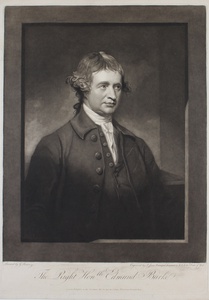| Method | Mezzotint |
| Artist | John Jones after George Romney |
| Published | London Publish'd as the Act directs, Decr. 10. 1790, by J. Jones, No.75 Great Portland Street. |
| Dimensions | Image 450 x 350 mm, Plate 505 x 355 mm, Sheet 533 x 390 mm |
| Notes |
A half length portrait of Edmund Burke. Burke is presented seated in a plain rectangular frame. He is looking off to the right, wearing simple, plain clothing and his natural hair, as opposed to a wig usually seen in this period. Edmund Burke (1729 - 1797) was one of the eighteenth century's leading statesmen, political thinkers and writers. His impact on the Regency age centres on his Reflections on the Revolution in France (1790), a major work opposing the French Revolution which laid the foundations of modern British conservatism. Originally a Whig, he showed liberal support for the North American colonies and Catholic emancipation. Despite his early reputation as a reformer, Burke's Reflections expressed fears that revolutionary ideals would violently destroy essential British traditions and institutions. These views led him to break with the Whigs and side with the Tories, for whom he became a figurehead. George Romney (1734 - 1802) was a British portrait painter, and was the most fashionable artist of his day, painting a variety of society's leading figures. In 1762, he moved from Lancashire to London, where he remained until 1799. Confident in painting portraits as well as history paintings, Romney was a rival of Sir Joshua Reynolds. John Jones (c. 1745 - 1797) was a British engraver, working in both mezzotint and stipple, and a publisher. Chaloner Smith ii/ii, NPG D32419 Condition: Repaired tear to left margin. |
| Framing | unmounted |
| Price | £320.00 |
| Stock ID | 48613 |

